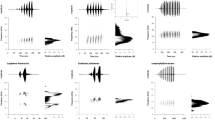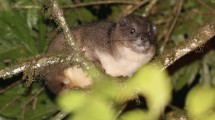Summary
Male treefrogs, Smilisca sila (Hylidae), produce calls of varying complexity and demonstrate a remarkable ability to synchronize their calls with those of neighbors. The bat Trachops cirrhosus eats frogs and uses the frogs' advertisement calls as locational cues. The bats are less likely to respond to synchronous calls than to asynchronous calls, and when given a choice prefer complex calls to simple calls.
Experiments with bat models indicate that, like other frogs, S. sila probably uses visual cues to detect hunting bats. In response to bat models the frogs decreased both the number and the complexity of their calls. The calling behavior of the frogs was sampled in the field during periods with and without artificial illumination. The frogs produced fewer and less complex calls, and they tended to call from more concealed sites, during the period without illumination, when presumably it would have been more difficult for the frogs to detect hunting bats.
S. sila tended to call from sites with higher ambient noise level, the noise primarily originating from waterfalls. The frequencies of the dominant energies in the waterfall sounds completely overlapped the frequency range of the S. sila call; thus waterfalls might mask the frog calls. When given a choice between calls produced near and away from waterfall sounds, bats preferred the latter.
Similar content being viewed by others
References
Alexander RD (1975) Natural selection and specialized chorusing behavior in insects. In: Pimental D (ed) Insects, science and society. Academic Press, New York, pp 35–77
Barclay RMR, Fenton MB, Tuttle MD, Ryan MJ (1981) Echolocation calls produced by Trachops cirrhosus (Chiroptera: Phyllostomatidae) while hunting for frogs. Can J Zool 59:750–753
Greenfield MD, Shaw KC (in press) Adaptive significance of chorusing in insects. In: Morris GK, Gwynne DT (eds) Mating systems of Orthoptera. University of Toronto Press, Toronto
Konishi M (1977) Spatial localization of sound. In: Bullock TR (ed) Recognition of complex acoustic signals. Dahlem Konferenz. FRG, pp 127–143
Otte D (1974) Effects and functions in the evolution of signaling systems. Annu Rev Ecol Syst 5:385–417
Otte D (1977) Communication in Orthoptera. In: Sebeok TA (ed) How animals communicate. Indiana University Press, Bloomington, pp 334–361
Passmore NI, Telford SR (1981) The effect of chorus organization on mate localization in the painted reed frog (Hyperolius marmoratus). Behav Ecol Sociobiol 9:291–293
Rand AS, Ryan MJ (1981) The adaptive significance of a complex vocal repertoire in a neotropical frog. Z Tierpsychol 57:209–214
Ryan MJ (1980) Female mate choice in a neotropical frog. Science 209:523–525
Ryan MJ (1982) Sexual selection and communication in a neotropical frog. Evolution (in press)
Ryan MJ, Tuttle MD, Taft LK (1981) The costs and benefits of frog chorusing behavior. Behav Ecol Sociobiol 8:273–278
Ryan MJ, Tuttle MD, Rand AS (1982) Bat predation and sexual advertisement in a neotropical frog. Am Nat 119:136–139
Schnitzler HU, Henson OW Jr (1980) Performance of airborne animal sonor systems, I. Microchiroptera. In: Busnel RG, Fish JF (eds) Animal sonar systems. Plenum Press, New York London, pp 109–182
Tuttle MD, Ryan MJ (1981) Bat predation and the evolution of frog vocalizations in the neotropics. Science 214:677–678
Tuttle MD, Taft LK, Ryan MJ (1982) Evasive behaviour of a frog in response to bat predation. Anim Behav 30:393–397
Wells KD (1977) The social behaviour of anuran amphibians. Anim Behav 25:666–693
Whitney CL, Krebs JR (1975) Mate selection in Pacific tree frogs. Nature 255:325–326
Author information
Authors and Affiliations
Rights and permissions
About this article
Cite this article
Tuttle, M.D., Ryan, M.J. The role of synchronized calling, ambient light, and ambient noise, in anti-bat-predator behavior of a treefrog. Behav Ecol Sociobiol 11, 125–131 (1982). https://doi.org/10.1007/BF00300101
Received:
Accepted:
Issue Date:
DOI: https://doi.org/10.1007/BF00300101




